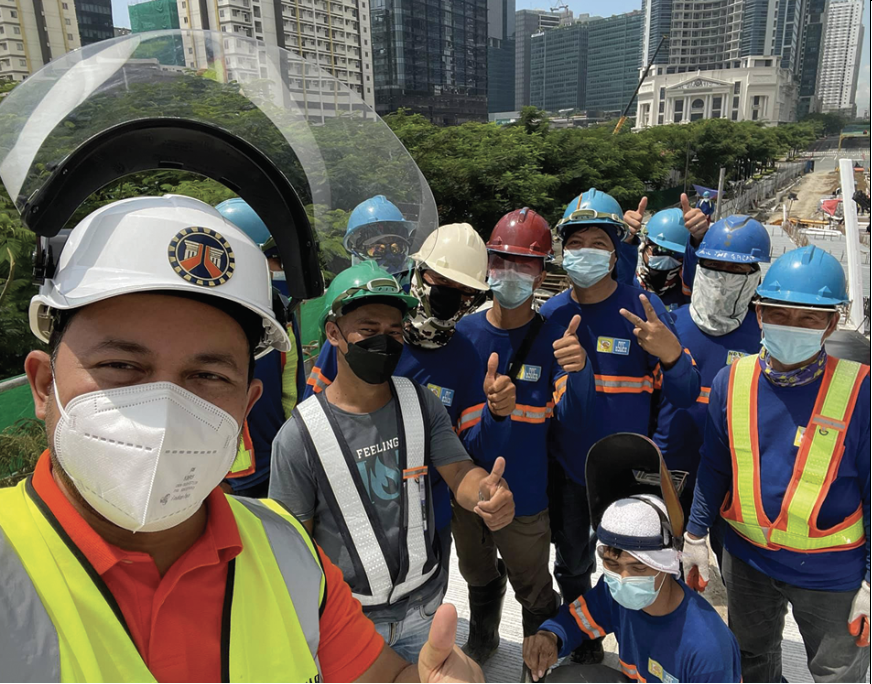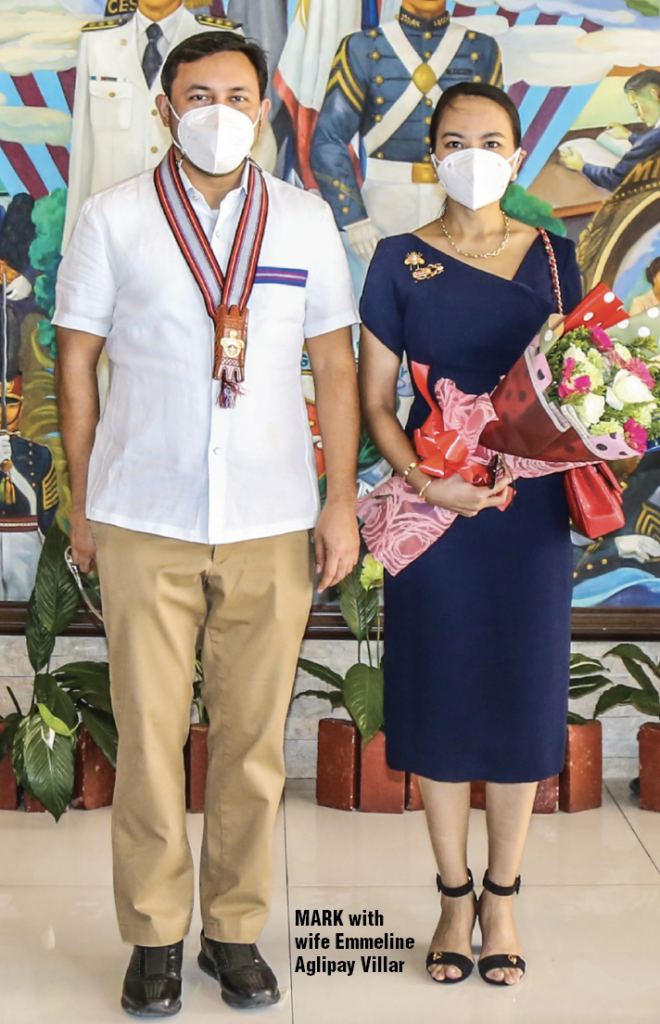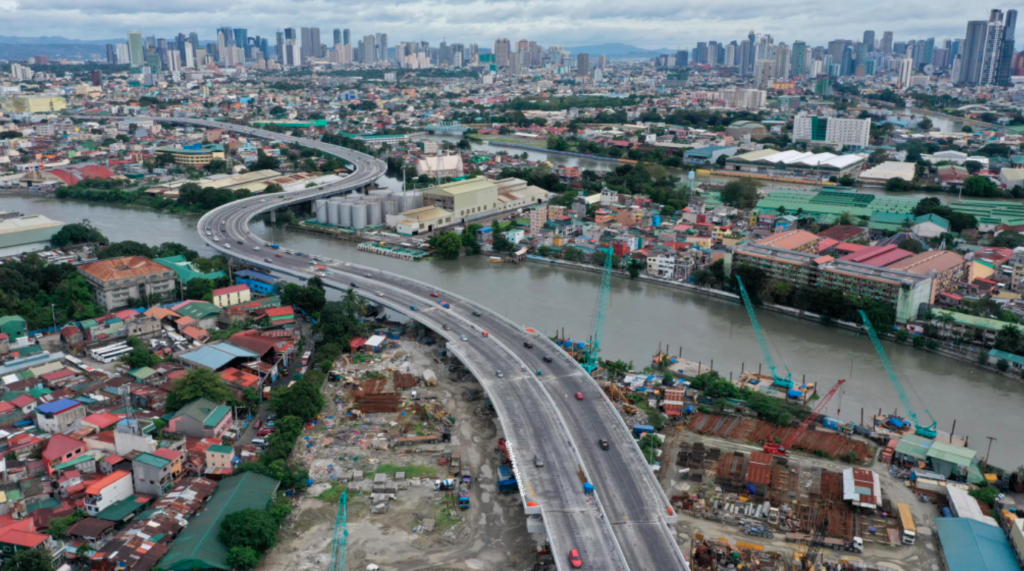If there is a solid achievement Rodrigo Roa Duterte can be justifiably be proud of, it is infrastructure.
Lawyer Duterte is the Mr. Build, Build, Build president.
As president, the Davao mayor of 23 years has put more money into infrastructure than any of his predecessors—easily P5 trillion in the last five and half years. The huge allocation easily exceeds the value of the combined infra spending of previous presidents, from Ferdinand Marcos (1965-1986) to Benigno Simeon Cojuangco Aquino III (June 2010-June 2016).

Anti-poverty strategy
“Build, Build, Build is the President’s main strategy to help Filipinos lift themselves out of poverty,” explains Finance Secretary Carlos Dominguez III.
Until the pandemic, the strategy had worked. Poverty incidence declined and the government rescued nearly six million Filipinos from abject poverty.
To raise the money for BBB, the government carried out robust tax reforms, raising revenue-to-GDP (Gross Domestic Product) ratio to as high as 16.1% by 2019, from a low of 12.9% in 2010. It also resorted to deficit financing.
Tax reform enabled government to collect P12.4 trillion in revenues from 2016 to 2020, 20% higher than the revenue collection of the Benigno Aquino administration in its six years.
From a meager 2.9% of GDP in 2015, infra spending nearly doubled to 5.4% of GDP in 2019, says Dominguez. In 2020, despite the pandemic, the administration still managed infra spending at a robust 4.8% of GDP.
Mark Villar did it
The principal agency that executed Duterte’s infrastructure plan, which is ambitious in scale and herculean in execution, is of course the Department of Public Works and Highways (DPWH) headed by a young technocrat, Mark Aguilar Villar.
Villar, 43, has a bachelor’s degree in economics, political science and philosophy from Wharton School of Finance, University of Pennsylvania. He has a master’s degree in business administration from the University of Chicago Booth School of Business. He spent six years in Congress as a congressman of suburban Las Piñas City (2010-2016).
Before his foray into public service, Mark served as president of property upscale developer Crown Asia Corp. and managing director of publicly listed real estate holding company, Vista Land and Lifescapes, the Philippines’ biggest home developer.
Scion of billionaires and veteran public servants
Mark is the younger of two sons of property tycoon Manuel B. Villar Jr., the former Senate president and speaker of the House of Representatives and the nation’s richest brown Filipino (BiznewsAsia estimates his wealth at $6.4 billion), and Senator Cynthia Villar who topped the senatorial elections of 2019 (25.28 million votes, the only senator to get majority vote, 53.46%, among the 12 winners). Mark is married to Emmeline, a topnotch lawyer and an undersecretary of justice. She graduated magna cum laude in economics from De La Salle University and finished law at UP. She is a TOYM awardee and formerly with SyCip Salazar Hernandez & Gatmaitan Law.

The elder Villar ran for president in 2010 but lost. “The day after Papa lost, he went back to work, in the family business,” recalls Mark. After politics, Manny Villar went on to become even richer, regaining an estimated P5 billion election campaign expenses within six months thru an IPO of another corporation.
“That’s one quality of the Villar family—resilience and hard work,” says Mark of his parents’ work ethic.
Villar gravitas
Villar brings to the DPWH inimitable gravitas and a solid brass-tacks knowledge of property development and how entire communities and cities are built, from scratch. Integral to such projects are roads. Roads give meaning to the time honored paradigm of location, location, location for a piece of property to be desirable and for communities and cities to be livable and sustainable.
For a cabinet post usually given a general or an engineer, Mark is the youngest to take the helm at DPWH.
For the DPWH’s almost superhuman achievements, the young Villar looks a good bet for senator in next year’s national elections, for a mother-and-son tandem in the Senate where future presidents are groomed. If he does well in the May 2022 polls Mark will be a formidable candidate for either president or vice president in 2028, fulfilling a dream his father failed to achieve.
“Mark Villar is the best DPWH secretary ever,” enthuses PR executive Jan Mata. Very few, if any, would contest that assertion. “He undertook reforms at DPWH to curb long entrenched corruption,” says the hard-hitting show, Daniel Razon’s “Bawal ang Pikon”.


Bright and hard working
President Duterte sums up Mark Villar’s sterling qualities: “He is not just a rich man’s kid. He is bright and very hard working.”
One major Villar reform at DPWH: geo-tagging. Projects are monitored by satellite and analytics to scan or spot ghost or delayed projects and rigged biddings. More than 30 contractors were blacklisted as a result of the geo-tagging and computerization.
The best antidote, of course, according to the Highways chief, “is people are afraid of the President who has no patience with corruption.” “We discourage and black-list ‘contactors’,” Mark says, using the pejorative term for sham or “low-bat” contractors.
Mind-boggling in scale and cost
The litany of numbers denoting DPWH’s achievements under Villar is mind-boggling. As of August 2021, the department has completed 29,264 kilometers (kms) of roads, with 15,134 kms still under construction; 5,950 bridges completed and 1,859 ongoing; 11,340 flood control projects completed and 4,155 ongoing; 150,000 school classrooms completed and 17,647 ongoing; and 222 evacuation centers completed and 105 ongoing.
In addition, Villar completed projects in support of tourism (2,436 kms completed), agricultural production and marketing (2,025 kms of farm to market roads and 95 kms of farm to milling facilities roads), industry and trade, 704 kms), and Katuparan linkages or Kalsada Tungo sa Paliparan, Riles and Daungan (443 kms of access roads completed).
Finally, there are 133 kms of security roads or Tikas Program (Tatag ng Imprastraktura Para sa Kapayapaan at Seguridad).
A tough job
Mark is proud of his work at DPWH. “What we have accomplished no administration ever accomplished in the past,” he says. “We have spent more than 5% of GDP on infra, the highest by any government. That never happened before.”
“Infrastructure has been neglected in the past. We need infra to develop as a country. You cannot modernize without infra. You cannot bring comfortable life to the people without infra. Comfortable life is what the Duterte administration promised to the people.”
“The job is tough, tougher than my previous stint in Congress,” says the secretary. “The President has told us to do many projects, all at the same time —roads, bridges, flood control, traffic,” he adds. “We just have to finish these things.”
“It’s a very fulfilling job. You are able to meet the needs of people in a big way,” says Mark. His one regret, he admits, “is I cannot spend more time with my daughter (Emma). I leave home with her still asleep. I come home with her already asleep.”
Mark describes the work of his 18,000-strong team at DPWH as incredible. “I have never seen government people work so hard,” he says.
Inspiration
What inspires Mark to carry on despite the punishing work at DPWH is “my wife and my daughter,” he says. “I want to leave a better world for my daughter and the people,” he dreams. “Everything I do is the future.”
Also, he says, “When I grow old, my daughter would see the things her father did for the country. Nothing else could give anyone dad that pleasure.”
Inspiration from Dad
Mark never dreamed of public works, although when he was young, dad Manny, a certified public accountant and an MBA, often discussed about building roads and highways.
“I just wanted to be a basketball player, a professional basketball player,” he smiles. The Villars were among the early supporters of then underdog 2016 presidential candidate Rodrigo Duterte who won by a landslide.
What convinced Mark Villar to take on the public works job is he experienced or saw the daily toll on the people of grossly inadequate infrastructure – poor or absent roads, floods, traffic, rampant poverty. After work, he wanted to go home early to his family—but couldn’t.
Mark is very self-effacing. He is painfully shy. “I leave to other people to decide how to remember me by,” he says. “My attitude is just like in basketball, at the end of the play, I leave everything to the court, knowing I have poured my all and my best into the game.”

Infra to power recovery
Amid the pandemic, the government looks upon infrastructure as a major plank of economic recovery.
“The infrastructure program will be key in driving economic recovery, restoring confidence, and bringing back jobs,” says Economic Planning Secretary Karl Chua. After infra spending reaching historic highs under the Duterte administration, Chua says “we are getting back on track.”
For his part, Finance Secretary Carlos Dominguez says “in the remaining period of the President’s term, we will rapidly modernize governance; accelerate the rollout of the infrastructure program; and continue with the market-friendly reforms attractive to investments.”
5% of GDP infra spending remains
Dominguez assures the government will also maintain the spending for the “Build, Build, Build” infrastructure program at above 5% of gross domestic product (GDP) to generate multiplier effects for the economy, such as creating more jobs and business opportunities.
“In the face of the unprecedented crisis brought about by the pandemic, the Duterte administration will continue to work hard until the very last minute of its term to ensure a legacy of a dynamic and market-driven economy for the Filipino people,” the finance chief assures inves-tors and Filipinos.
Dominguez points to the 11.8% GDP expansion in the second quarter as proof of the economy’s strong capacity to return to the path of rapid expansion, as reflected in higher revenue collections.
Game changers
Many of the government’s infra projects are game changers.
When Duterte came to power in 2016, average infra spending of past administrations was nearly stagnant at 2.5% of GDP.
The International Monetary Fund had scored the Philippines’ poor public investments in infra compared with its ASEAN neighbors.
As if to make up for lost time, Mark escalated infra spending. Along with the Department of Transportation, DPWH’s infra spending in the first four years alone, a colossal P3.417 trillion (see table, page 18) exceeded by P419 billion or 14% the combined P2.99 trillion infra spending of the four previous presidents, from Fidel Ramos to Benigno S. Aquino III (1992-2016). The four-year P3.4 trillion spending surpassed by P1.63 trillion or 91% the P1.784 trillion spent by the BS Aquino administration in six years.
6.5 million jobs created
In the first five years of the Duterte ad- ministration, infra generated 6.5 million jobs. This 2021, despite the pandemic, another 1.6 million jobs were created.
To achieve that, the DPWH instituted reforms. It changed the rules for right of way (ROW), with a new Right of Way manual. It created 2,079 positions. Appraisal of property values under ROW was speeded up, thru a memo of agreement with the Land Bank, enabling claimants to get paid promptly.
Special Expropriation Courts were created to focus on expropriation cases. Also, when a contractor slips by 5%, he is warned; and blacklisted if the delay is 15% of timetable.
Metro Manila traffic
One of Duterte’s earliest orders was to fix the colossal traffic jam in the national capital. DPWH launched an EDSA Decongestion Plan worth P240 billion.
The grand scheme involves the construction of 11 bridges and 14 roads and expressways. The objective is reduce EDSA’s vehicular load, 288,000 daily, by 120,000 vehicles.
Skyway Stage 3
The most important component of EDSA decongestion is the 17.93- km Skyway Stage 3, a project of San Miguel Corp.. The expressway was inaugurated on Jan. 14, 2021, the birth anniversary of SMC President Ramon S. Ang. Duterte himself showed up for the inaugural and sang happy birthday to the SMC top honcho.
Skyway 3’s impact has been dramatic. Travel time from Buendia in Makati to Balintawak, in Quezon City has been reduced from two hours, to 15 to 20 minutes today.
Without DPWH’s intervention, relates Villar, “Skyway 3 could not be completed –on time. It was 8% completed in civil works in 2018.” Before DPWH entered the picture, only four of 47 national transmission poles had been relocated. Alignment had to be re-aligned at many intersections.
Duterte intervenes
Duterte himself ordered the relocation of the National Grid poles and the realign- ments. Instead of Skyway 3 ending at North EDSA, it now exits right at the North Expressway. “This is political will,” gushes Villar.
According to Villar, the Skyway 3 project would have been far in the future if not for the commitment of the DPWH men and women and the dedication of the project concessionaire San Miguel led by Ramon Ang and its civil works contractor.
Vexed by long delays, DPWH accelerated the Skyway’s infrastructure right-of-way (ROW) acquisition by forming a road right-of-way task force that resulted in delivery of site possession and increased overall civil works accomplishment.
Another miracle was achieved at the NLEX Harbor Link. Before its completion, travel from Caloocan to Valenzuela took one hour. That is now only 5 minutes. NLEX’s Radial 10 had bogged down for 10 years, also because of ROW issues. DPWH intervened. In six months, the snag was solved. Today, one can drive from NLEX to Port Area in Manila in just 10 minutes, from 60 mins. previously.
A connector road to Skyway 3 is being rushed so that every city in Metro Manila will be connected in just 20 to 30 minutes.
DPWH has built the first highway near Metro Manila with a dedicated bike lane—the Laguna Lake Highway. It cuts travel time from Taytay to Bicutan by half, from one hour to 30 minutes.
DPWH is completing 11 bridges across the Pasig River to ease traffic, principally on EDSA. The Binondo-Intramuros Bridge will service 29,000 vehicles a day; Estrella-Pantaleon Bridge connecting Makati and Mandaluyong, 50,000 vehicles a day.
Cebu
In Central Philippines, the DPWH is building the 68.5-km Metro Cebu Expressway. The section, from Naga City to Danao City, is nearing completion. Travel along this road used to be three hours. It will be cut to one hour and 10 minutes.
The 8.5-km Cebu-Cordova Bridge is the longest bridge in the Philippines. Completed in early 2022, it connects Cebu to Mactan, where the airport is.

Davao
Further south, the Davao City Coastal Road will reduce to 15 mins. travel time from Toril to Poblacion, from 45 mins.
SPINE Road
Perhaps, the most ambitious of DPWH’s road projects is the Luzon Expressway Network, from Ilocos in the north to south of the Philippines’ main island. Travel will be reduced by more than half, from 20 hours to an unheard of 9 hours.
SPINE features the 89-km Tarlac-Pangasinan-La Union Expressway (TPLEx) which makes a trip from Manila to La Union a breeze and further to Baguio an invigorating experience.
Meanwhile, the just completed 30-km Central Luzon Link Expressway between Cabanatuan and Tarlac cuts travel from 70 minutes to just 20 minutes.
South of Manila, 44-km the Cavite-Laguna Expressway saves drivers 10 minutes, from 40 to 30. Also, the 66-km TR4 will connect Batangas and Quezon seamlessly.
